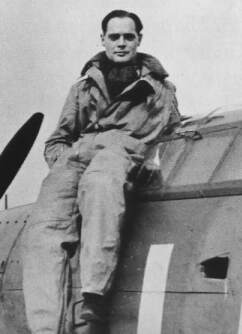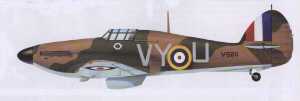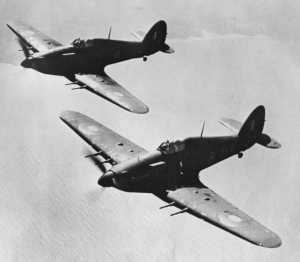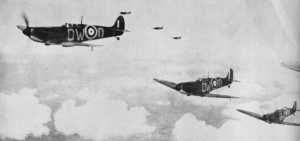Douglas Bader
British Ace of World War Two
By Stephen Sherman, Dec. 2002. Updated July 5, 2011.
The Bristol Bulldogs roared over the RAF Woodley airstrip as three pilots put the biplanes through their paces. As the third pilot, a 21 year-old whiz named Douglas Bader, came in for a landing that December morning in 1931, he did a low roll and caught a wing. The plane crashed in a smashed-up heap; the pilot was critically injured.
Rushed to the hospital, the doctors amputated his right leg. He barely survived the shock of the accident and the amputation, and two days later, his left leg was also amputated.
Despite this terrible loss, Douglas Robert Steuart Bader was determined to fly again and he began a long struggle to resume flying with the RAF. He first learned to walk with aluminum alloy artificial legs and then to drive a car. He next passed a flight test at Central Flying School, only to be rejected by the Medical Board. Apparently, there was "nothing in regulations" to cover a pilot with artificial legs. After a brief assignment to the Transport section at Duxford fighter station, Bader was forcibly retired from the RAF on medical grounds, with a disability pension of 200 pounds. During his convalescence, he met and fell in love with Thelma Edwards. Because of his poor financial circumstances, they were secretly married and she continued to live with her parents. By October, 1933, he was working for Asiatic Petroleum Company at 250 pounds a year, but still could not afford a flat until 1937. By that time, he had mastered golf and even tennis; and he was financially secure enough to marry Thelma in a church service.
In September 1938, as war clouds gathered over Europe, he re-applied to the Air Ministry, who offered him a desk job. He wasn't interested; he wanted to fly. He kept trying. In early 1939, Air Marshal Sir Charles Portal wrote him that, in the event of war, the RAF would "almost certainly" let him fly, if the doctors agreed.
War
When World War Two started in September, 1939, he continued to lobby to serve with the RAF. He was ordered to report for a medical, but once again, the RAF wanted him for ground duties. He eventually passed the medical, with a helpful recommendation from Air Vice-Marshal Halahan, and reported again to Central Flying School in October. An old friend Squadron Leader Rupert Leigh tested him; after seven years, his flying skills hadn't deserted him. He soloed on November 27, 1939. With the war on, his flying career moved along rapidly: Flying Officer with No 19 Sqn in Feb. 1940, Flight Lieutenant with 222 Sqn in April, and his first combat in May.
Dunkirk
222, a Spitfire squadron, had been held in reserve, in the north, at Kirton-on-Lindsay. In the last days of May, when the beaten British armies pulled back toward the beachhead at Dunkirk, 222 Sqn was sent south, to Martlesham, near the Suffolk coast. From there, the squadron helped to cover the beaches and the pilots could see the desperate situation on the ground. On the morning of the 31st, Bader shot down a Bf 109 (Me.109), got separated from his comrades, and returned to base by himself. Later in the day, on a second sortie, he flamed a Heinkel He 111, a twin-engine German bomber.
242 Squadron
The mostly Canadian pilots of 242 Sqn had taken a beating in the Battle of France; half its men were casualties; its equipment was porly maintained; its morale was rock-bottom. When "the legless wonder," Douglas Bader, was made Acting Squadron Leader it June, 1940, the pilots thought it would be more of the same. But Air Vice-Marshal Trafford Leigh-Mallory had purposefully selected the indomitable Bader for the challenge of leading the Hurricane pilots of 242 Sqn.
Powered by 1030 HP Merlin engines, their Mark I Hawker Hurricanes could reach 320 MPH, not quite as fast as contemporary Bf 109s, but with a tighter turning radius, the Hurricanes could hold their own.
Bader made his mark immediately, by sacking two flight leaders, by enforcing discipline, and by raising a holy ruckus when he had difficulty getting spare parts. With their morale on the rise, the 242 Sqn fliers chafed to get into the action throughout July and August. As part of No. 12 Group, whose bases spread across Britain's midsection, the only times that 242 could engage the Germans was when they flew to a southern field early in the morning.
August 30, 1940
It was a fine morning, at 6AM when Bader's batman left a cup of tea in the Squadron Leader's bedroom at Coltishall Fighter Station, north of Norwich. Bader put on his prosthesis, shaved, bathed, and dressed in his blue RAF uniform, as quickly as any two-legged man. In half an hour, he was eating toast and marmalade with 66 Squadron Leader Rupert Leigh. Still anxious to get into the fray, he drove to the 242 dispersal area where his pilots waited.
The phone rang. It was Operations; they were needed in the south. The pilots ran for their planes. Bader's Hurricane stood ready for him, with its parachute already stowed (contrary to usual procedure). Two crewmen helped him into the cockpit. He first stepped onto a wing, then swung one leg inside. Grasping the side of the cockpit, he swung the other leg in and then lowered himself into his seat. The pilots checked their instruments, started engines, and began to taxi toward their take-off spots. With Bader in the lead, the twelve Hurricanes of 242 Sqn took off and headed south at a modest speed, only to be ordered back within fifteen minutes.
They cooled their heels at Coltishall for an hour, only to be ordered up again. Just after 9AM, the four sections were in the air, bound for Duxford. This time, they were not recalled and they touched down half an hour later. But it was still more waiting; Wing Commander Woodall informed Bader that his squadron was to be held in reserve. During the afternoon, more German raiders come over the Channel, but other squadrons dealt with them. 242 stayed put.
By 4:45, they figured that their day was over, when the radar stations picked up multiple waves of German planes. "Scramble!" Bader hurried to his plane, climbed in, throttled up, and roared off, over the grassy airstrip with the other leaders and their sections close behind.
- F/Lt. Eric Ball - Yellow section
- F/Lt. George Christie - Green section
- F/Lt. Georgie Powell-Shedden - Blue section
They headed due south, alerted to German aircraft coming over North Weald at 15,000 feet. Their Merlins roaring at full power, the three sections follow Bader, plotting to stay "sunward" of the enemy. Bader switched on his gunsight and adjusted its small yellow circle of light to match the expected twin-engine medium bombers.
Over Hertford, east of London, his radio came on, "Blue Leader to Laycock Leader (Bader's callsign), three bogies, three o'clock low." He ordered Powell-Shedden's Blue section of three fighters to check them oout, while the other nine planes of 242 continued on their orginal course, at full throttle, climbed to 14,000 feet. The British radar air defense contoller, "Steersman," continued to guide them, on course 240 degrees, to intercept the Germans. At 5PM, as they reached 16,000 feet, they still saw nothing.
Contact
Steersman reported that North Weald was under attack. Bader's wingman, Willie McKnight, spotted them first, many dots, two large groups of bombers. Then, above them, fighters too. Green section went after the fighters, while Bader led the remaining six Hurricanes after the bomber force: Dornier Do 17s with Messerschmitt Me 110s mixed in amongst them.
Bader's Hurricanes banked steeply left, then dived, and came at the German planes from out of the sun. As the British fighters streaked into their formation, the Luftwaffe pilots scattered wildly. Having built up tremendous speed in his dive, Bader pulled out at the bottom of his arc and picked out the trailing 110 from a group of three.
He kept the twin-engined fighter in his gunsight, even as it climbed and turned evasively. He closed ... and closed ...
Then he thumbed the trigger, and the gunfire from eight thirty-caliber machine guns shook his plane and smashed into the 110. Flames leapt out of the wing root and it went down trailing smoke. He looked around, and couldn't find any other Hurricanes.
Below him was another Me 110. He dived right after it, Just as he lined it up in his gunsight, the pilot pulled up and Bader followed tightly. In an odd tactic, the German pilot pulled up and then repeatedly. Once again, Bader closed in, and his eight Brownings spat lead into the starboard wing. Chunks flew off, flames broke out, and the 110 went down, Bader's second victory of the day.
Looking back, he spotted a 110 behind him and instantly cranked his Hurricane in the tightest possible right hand turn. As Bader threatened to turn inside the bigger German plane, its pilot dived away. With it head start and heavier weight, it eluded Bader's Hurricane. Bader climbed again and surveyed the sky. Empty! He headed north and radioed his intention to return home. A single fighter approached, McKnight joining up. Bader smiled and held up two fingers; McKnight three. Soon another 242 Hurricane fell into formation with them and then another. Five of them landed at Duxford together.
The usual clusters of ground staff gathered around, especially interested because his gun ports were blackened. The Intelligence Officer questioned him and he promptly wrote out his action report. (WW2 pilots filed these after every mission, when the details were fresh in their minds. These action reports allowed the pilots themselves or other writers to relate minutely detailed air battles, years after the fact. - SS) Actually, all twelve of 242's planes made it back safely to their home base at Coltishall; they had shot down an even dozen German aircraft.
The Big Wing Debate
The success of 242 Squadron that day convinced Bader that an even larger group of fighters would have had an even greater success. He claimed that if he had three squadrons (36 planes), he could have inflicted commensurately larger damage on the Luftwaffe. This tactical proposal, the "Big Wing," put him in the middle of the rivalry between his own boss - Air Vice Marshal Leigh-Mallory (12 Group commander) and Air Vice Marshal K. R. Park (11 Group commander). Park's fighters, based in southern England, had less time to form up into larger groups. Leigh-Mallory (and Bader) insisted that large groups would be much more effective. The argument was never really settled, and continues to be contentious among aviation historians, down to the present day.
A few months later, Park (and his boss, Air Marshal Sir Hugh Dowding) were given other assignments. Leigh-Mallory and the Big Wing advocates were given 11 Group. But by then, the Battle of Britain had been won and the debate was over.
September
He led 242 Sqn on the 7th and they claimed eleven kills. On the 9th, he led three squadrons (242, 310, and 190); they downed twenty German planes. Throughout the month, Park and Leigh-Mallory feuded over tactics and turf. As the both the aerial and bureaucratic battles raged, "Tin Legs" Bader continued to lead RAF Hurricanes into the sky. On Sept. 15, he had charge of 242, 310, 19, 302, and 611 Sqns, and this "Big Wing" made 52 claims. He received the DSO for his extraordinary leadership and heroism in these battles.
He led the Duxford wing through the end of the Battle of Britain, accumulating twelve victories. In 1941, he led the Tangmere Wing, as the RAF took the offensive. Flying Spitfires, the Tangmere squadrons (145, 610, and 616) Under his aggressive leadership, they flew repeated fighter sweeps over France. His score mounted over 20.
On August 9, 1941, his luck ran out. Flying over Le Tourquet, he collided with a Bf 109 and went down. He struggled to escape the cockpit, as his legs were trapped. He pried himself loose, opened his parachute, and was promptly captured by the Germans. The great German ace, Adolf Galland, arranged for Bader to visit Jagdgeschwader 26.
Not long afterwards, Bader, a double amputee, contrived to escape from the hospital where he was being held, slipping out of his window using sheets tied together. His rendevous with the underground was betrayed, and he was recaptured. This time he was sent to high-security Colditz Prison. Despite this, the Luftwaffe cooperated in delivering to Bader a pair of artificial legs that the British air-dropped into France. He stayed at Kolditz (sp?) until April, 1945. His decorations included the DSO and Bar, the DFC and Bar, the Legion d'Honneur, and the Croix de Guerre.
Bader survived the war, worked for Shell Oil, was knighted in 1976 by Queen Elizabeth for his services to amputees, and passed away in 1982.
Recommended Web sites:
Remembering the Battle of Britain
Recommended Books:
The Battle of Britain: The Greatest Air Battle of World War II, by Richard HoughSpitfire Mark II Aces 1939-41 (Osprey Aircraft of the Aces, No 12), by Alfred Price - featuring stories of ten leading Battle of Britain aces




